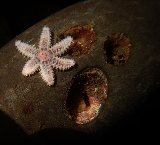
Leptasterias aequalis
Encyclopedia
Leptasterias aequalis, common name
s little six-rayed seastar or six-armed star, is a species of starfish.
This is a small species, with a total width of only about 5 centimetres (2 in). The coloration is extremely variable.
This seastar is found in the eastern Pacific Ocean
, from Washington to Southern California
. It lives on rocky shores, in the mid intertidal zone
.
Many sea-stars broadcast spawn their embryos, where fertilization occurs in the water column, however Leptasterias species brood their embryos locally. The stars form mating aggregations and the female sits on her brood for a period of 6-8 weeks while the embryos develop underneath. Eventually the embryos fully metamorphose into juvenile sea-stars and walk away, and thus can only locally disperse.
Common name
A common name of a taxon or organism is a name in general use within a community; it is often contrasted with the scientific name for the same organism...
s little six-rayed seastar or six-armed star, is a species of starfish.
This is a small species, with a total width of only about 5 centimetres (2 in). The coloration is extremely variable.
This seastar is found in the eastern Pacific Ocean
Pacific Ocean
The Pacific Ocean is the largest of the Earth's oceanic divisions. It extends from the Arctic in the north to the Southern Ocean in the south, bounded by Asia and Australia in the west, and the Americas in the east.At 165.2 million square kilometres in area, this largest division of the World...
, from Washington to Southern California
Southern California
Southern California is a megaregion, or megapolitan area, in the southern area of the U.S. state of California. Large urban areas include Greater Los Angeles and Greater San Diego. The urban area stretches along the coast from Ventura through the Southland and Inland Empire to San Diego...
. It lives on rocky shores, in the mid intertidal zone
Intertidal zone
The intertidal zone is the area that is above water at low tide and under water at high tide . This area can include many different types of habitats, with many types of animals like starfish, sea urchins, and some species of coral...
.
Many sea-stars broadcast spawn their embryos, where fertilization occurs in the water column, however Leptasterias species brood their embryos locally. The stars form mating aggregations and the female sits on her brood for a period of 6-8 weeks while the embryos develop underneath. Eventually the embryos fully metamorphose into juvenile sea-stars and walk away, and thus can only locally disperse.
External links
- Lots of good information at: http://www.wallawalla.edu/academics/departments/biology/rosario/inverts/Echinodermata/Class%20Asteroidea/Leptasterias_aequalis.html
- Two good images at: http://calphotos.berkeley.edu/cgi/img_query?stat=BROWSE&query_src=photos_fauna_sci-Invertebrate&where-lifeform=Invertebrate&where-taxon=Leptasterias+aequalis&title_tag=Leptasterias+aequalis

